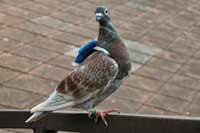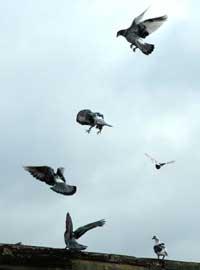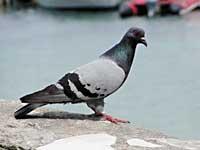Hierarchy in palomeros balances
2010/05/09 Aulestiarte Lete, Izaro - Elhuyar Zientziaren Komunikazioa

We all know the artistic flights of pigeons. We have often looked at the spectacular movements of these birds and are accustomed to their pirouette and their rapid changes of direction. But depending on what does a dove choose the direction of its flight? Is it a collective decision? For that has so far been a mystery, especially because of technical difficulties, since it is considered almost impossible that any movement of a group of pigeons can be recorded with a camera.
However, scientists from the universities of Budapest and Oxford have recently explained that in these fast flights birds always follow the dove that presides or leads the group. That is, in addition to the position, they make decisions hierarchically. According to biophysicists of the University of Budapest, Eötvös Loránd, this is the first research that demonstrates the hierarchical decision of a group of birds. In addition, they believe it can serve to understand the collective behavior of other animals.

The balance leader decides when and where to make the change of direction and the rest imitates the movement in a few seconds. (Photo: Zsuzsa Ákos).
The GPS system has allowed this conclusion. The “miniaturization” of the system has been, in particular, the key to the study. In fact, the device that is applied to the pigeons by a backpack weighs only 16 grams, which has allowed to directly control and observe their flights without the experiment affecting the mobility of the birds.
As GPS detect direction changes in fractions of seconds. Thus, they performed the experiment with ten trained pigeons and were able to know the exact position of each of them every 0.2 seconds. Examining the free flights of about 15 kilometers, the researchers have known the changes of direction made by each dove. In addition, the location of the pigeons that have introduced these changes in the group and the frequency with which the members of the balance have imitated this movement has been analyzed.
The results obtained have been published by the journal Nature. In fact, researchers have detected a well-defined hierarchy in their balances. Pigeons mimic the changes of direction made by the group leader (between 0.4 seconds) and normally the leader is in front of the group. In addition, curiosity has shown that common pigeons fly lower and to the right than the leader. Why? Because, according to experts, birds prefer to take advantage of the view of the left eye to better control the leaders (related to the structure of the brain of birds and the processing of information).
“A fascinating balance”

Pigeon research can also serve to understand the collective behavior of other animals. (Photo: Zsuzsa Ákos).
However, the leaders of the balances also change, they are not always the same. Sometimes, in addition, the pigeons that are supposedly in the most modest positions of the hierarchical structure assume the direction of the flight. Experts believe they act almost democratically. In his opinion, the reason for this is probably more related to the evolution of the species than to political leadership.
In general, researchers believe that such flexible and dynamic behavior between leaders and followers is much better than being always subordinate to a leader, because it can be a way to make truly effective decisions. Princeton University biologists are also clear: “The balance between democracy in palm oil balances and hierarchical control is fascinating.”
Published in 7K.

Gai honi buruzko eduki gehiago
Elhuyarrek garatutako teknologia



